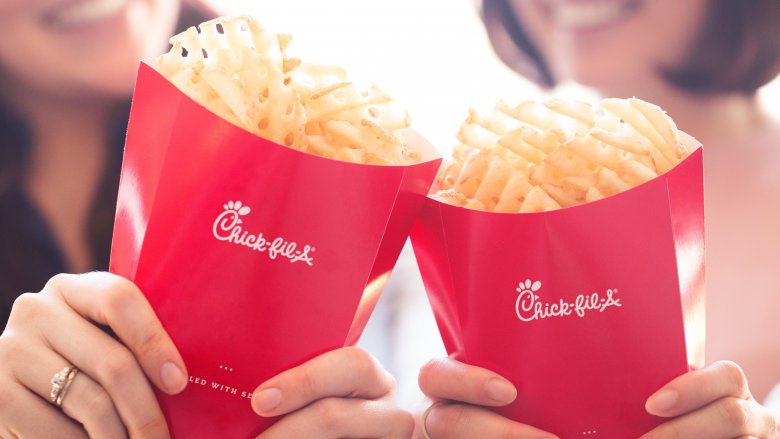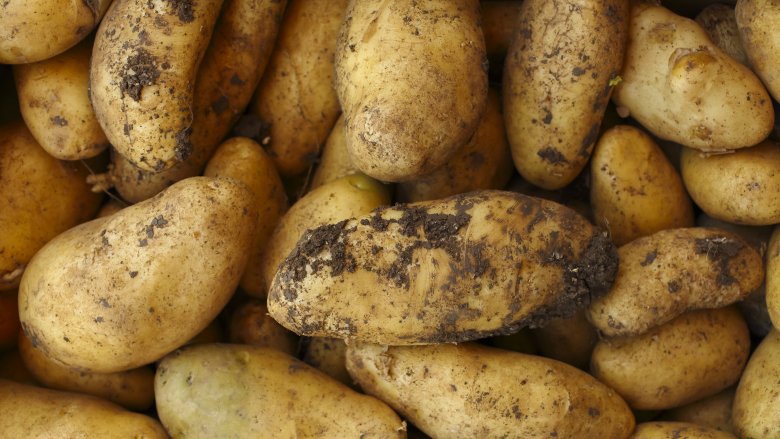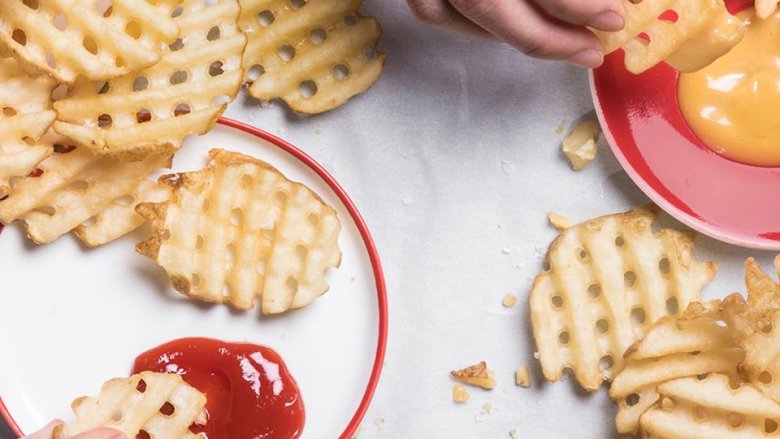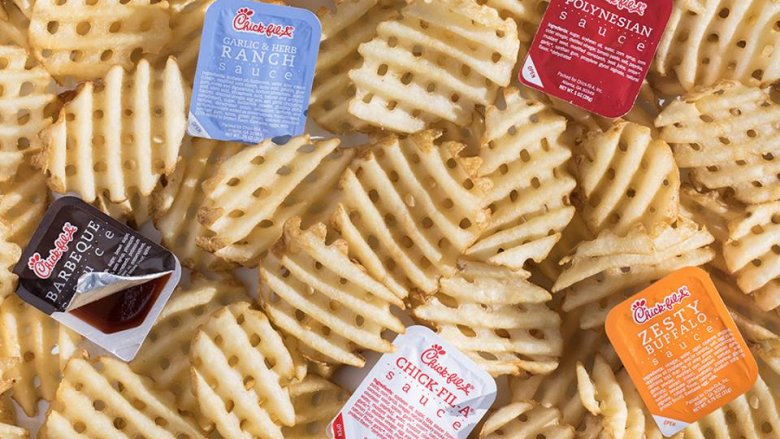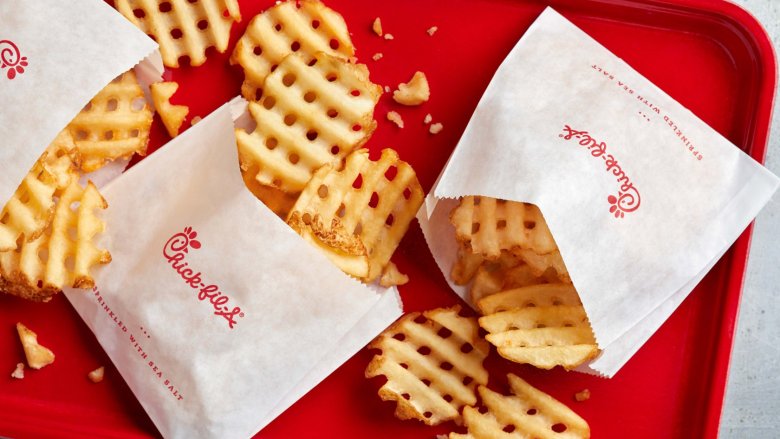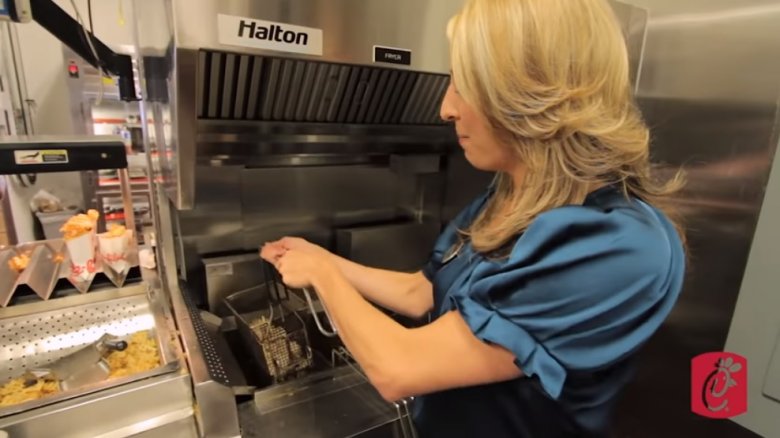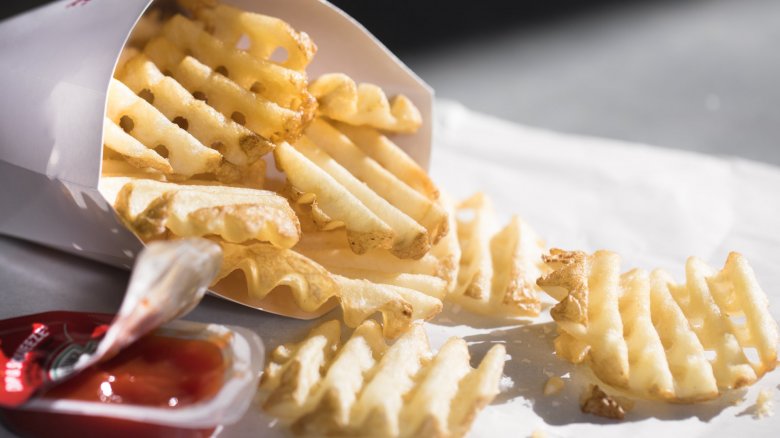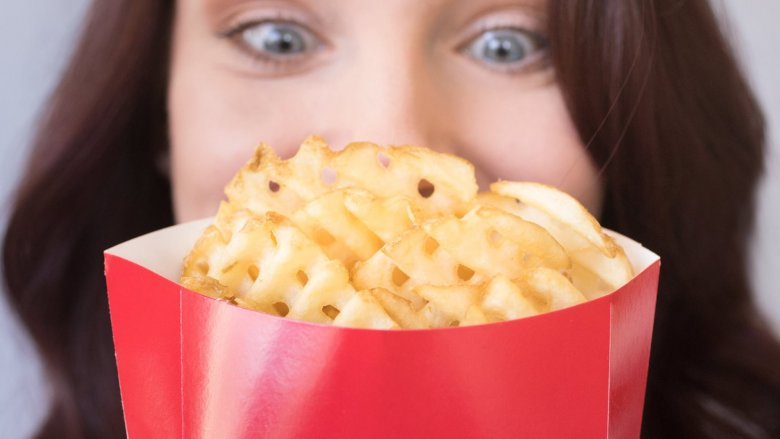Chick-Fil-A Waffle Fries: How They're Really Made
For those who love potatoes there is nothing more satisfying than that of one sliced, fried to perfection, and served as a french fry. Now imagine those savory, oil-fried, crispy, thin-cut potatoes being even better. Is it possible? According to Chick-fil-A, the answer is yes and they call them waffle fries. Although Chick-fil-A may not have invented the waffle fry, they have sure built an empire around it. For a restaurant that all began around a chicken sandwich, that sandwich now takes a back seat to the waffle fry.
Introduced in 1985, 18 years after the opening of the first Chick-fil-A in Atlanta, the waffle fry is now the number one selling item on the chain's menu. Perhaps it's the thickness of the waffle fry, the unique shape, or the actual potato itself that makes them irresistible. Either way, founder S. Truett Cathy would be proud of the waffle fry boom enjoyed in more than 2,400 Chick-fil-A restaurants across the United States. Chick-fil-A is still expanding its reach and even crossing the border up into Canada, introducing its first international location in Toronto. Pretty cool, eh?
So, what is it about Chick-fil-A's waffle fries that causes such a frenzy? Let's take a look at the carefully crafted steps in the waffle fry-making process that make this menu item such a phenomenon.
Chick-fil-A waffle fries start with great farmers
The "A" in Chick-fil-A stands for Grade A quality. That means that the Atlanta-based restaurant wants nothing less than perfection in the food each location is serving to its customers daily. This is especially important for the number one selling item on the menu — waffle fries.
Producing a mouthwatering waffle fry means not settling for mediocre potatoes. That is why Chick-fil-A sources all potatoes for their waffle fries and hash browns from the states of Washington and Oregon. We are talking hundreds of millions of potatoes each year, particularly from farms down in the Columbia River Basin where the people care just as much about Chick-fil-A's customers as the restaurant itself.
"A lot of time, effort and care goes into raising these potatoes," says Nick Johnson, a fourth-generation farmer who proudly has his hands in every part of the potato process. "We do everything we can to make sure we're growing high-quality food." This isn't surprising considering that Chick-fil-A takes great care in choosing their suppliers, ensuring they follow very strict quality and safety standards. Creating the country's best quality potatoes doesn't come easy. From watering the land to tending the soil all the way through digging, so much care goes into growing the spud that will soon become a Chick-fil-A waffle fry. In the busy season Johnson says you'll find him in the field nearly 75 hours a week. Remember that the next time you bite into a waffle fry.
Volcanic ash is one of the secrets of success for Chick-fil-A waffle fries
Bob Hale is another farmer proudly providing Chick-fil-A potatoes out of Oregon. When asked the secret to a good potato Hale says, "Good soil, good water, good weather, and good people." What is it about the soil in the Columbia River Basin that makes it such an ideal place to grow potatoes? The answer — volcanic ash.
If you're up to speed on your geography, you know that Mount St. Helens is a volcano located in southwest Washington that erupted in 1980. The eruption disintegrated more than 230 square miles spewing over 540 million tons of ash. To put that into perspective, a midsize SUV weighs about 2 tons.
After the eruption, mineral and nutrient deposits that were in the rock of Mount St. Helens were then deposited within the surrounding basin. When ash is periodically added into existing soil, it actually improves soil quality, maintains moisture and helps with productivity. It's crazy to think such devastation can provide any benefit, but in the case of potatoes (and the waffle fries they eventually become), it can.
Chick-fil-A cuts its waffle fries in secret
Chick-fil-A is pretty good at keeping secrets when it comes to the magic that creates their menu items. For instance, their chicken sandwich has remained unchanged for over 50 years, and the recipe continues to be top secret. The same secrecy applies to their waffle fries.
What happens to the potatoes once they leave the farm? Where do they go? How do they go from a potato to a waffle fry? That seems to be a secret Chick-fil-A is keeping under wraps. What happens between the time the potatoes leave the farm and the boxes of fries arrive at stores remains a mystery. Although we might not know where the potatoes go to be processed and cut, what we do know is that it takes a total of 115 days for potatoes to grow and then be made into waffle fries.
The fact that the waffle fry recipe has remained unchanged since inception seems like a good reason to keep the process in the Chick-fil-A family. Since Chick-fil-A thrives on tradition, it wouldn't be out of line to say that this recipe probably isn't changing anytime soon.
Chick-fil-A waffle fries arrive at stores pre-cut and frozen
We might not know who cuts them, but when waffle fries arrive at Chick-fil-A restaurants across the country, they arrive in large boxes. Inside those boxes, a former employee said on Quora, you won't find homegrown potatoes — you'll find brown paper bags filled with frozen, already-cut waffle fries. Those boxes are then placed in the freezer and bags are grabbed as needed, which is quite often when it comes to the popular menu item.
One New York City-based Chick-fil-A goes through up to 240 bags of waffle fries a day. With each box containing about 6 bags of fries, that's a whopping 40 boxes of waffle fries each day. Chick-fil-A obviously has some pretty large freezers onsite to hold all of those fries. No wonder there is a designated fry cook position at Chick-fil-A. With an average of 240 bags of fries being used on the daily, employees must be constantly putting in and pulling out fries from the fryer. Do you think any of them snag a fry or two?
With Chick-fil-A waffle fries, the skin stays on
When you grab your first waffle fry from your Chick-fil-A order, you might not notice. You're probably distracted by the crispy outside texture and large surface area that can hold record amounts of one of Chick-fil-A's gourmet dipping sauces, but by the time you get to the end, you'll see it. It's hard not to notice. Those last few pieces in your waffle fry order. They're missing something — the holes. But, why? Why would Chick-fil-A put you through that kind of torture? Why would they turn something so beautiful into something that looks like an unbaked potato chip on one side? According to Chick-fil-A, the answer is simple. It's because they use real potatoes. And as they say, since "no two potatoes are the same," you might end up with a few of what they call potato skin fries.
Customers, like one Reddit user, find it hard to grasp, but the no-hole potato skin fry is a Chick-fil-A staple. It comes with the territory. So, next time you order up a side of waffle fries from the counter, know that most likely you'll come across a fry butt or two.
Chick-fil-A waffle fries are cooked for exactly two minutes
Timing is everything when it comes to the perfection of Chick-fil-A's waffle fries. If you've ever burnt a piece of toast or pulled chicken off the grill a little too early, you know that being a little off on the timing could mean disaster when it comes to taste. For a restaurant that serves hundreds of bags of waffle fries a day, consistency is important. Luckily, Chick-fil-A has the cooking of their waffle fries down to a science.
Once the frozen fries are poured into the fry basket, they are then lowered into the fryer. At this point, the fry cook only has to press the waffle fry button on the machine to get the process started. The waffle fry button is set to cook for two minutes. It's really that simple. After two minutes, they're are pulled from the fryer crisp and golden, and those oh-so-tender Chick-fil-A waffle fries are ready to be seasoned.
Two ingredients make Chick-fil-A waffle fries taste so good
Chick-fil-A founder S. Truett Cathy said, "Food is essential to life. Therefore make it good." There's no doubt Chick-fil-A waffle fries are good, but it might surprise you to know how simple they actually are. There are just two main ingredients Chick-fil-A uses to bring out that monumental flavor of those crispy-on-the-outside and tender-on-the-inside waffle fries.
Waffle fries are poured into a fry basket and dipped in a certain type of oil when cooking: canola. Once the timer goes off, the fries are shaken of all excess oil. But after the oil and before the serving comes one final ingredient. All Chick-fil-A waffle fries are topped with a touch of salt. Chick-fil-A uses two pumps of sea salt from its special salt shaker, and that gets sprinkled over the waffle fries. Then they're tossed around with that perfect amount of salt to bring out the real potato flavor in each bite. Can you believe such flavor comes from so few ingredients? Aside from the canola oil and the salt, there are only a few other ingredients in Chick-fil-A waffle fries: disodium dihydrogen pyrophosphate and dextrose for color retention, and dimethylpolysiloxane in the oil as an anti-foaming agent. That's pretty minimal compared to other fast food restaurants like McDonald's and Wendy's.
Employees are always watching the clock to ensure you get the freshest Chick-fil-A waffle fries
Serving the crispiest and freshest waffle fries to Chick-fil-A customers means paying attention to the clock. Once the waffle fries are cooked and ready to be served, Chick-fil-A gives just a five minute window for them to be consumed. What happens to any leftover fries sitting after those five minutes? "If they're beyond five minutes," franchise owner Johnathan Winn says, "we have to destroy them." Those poor waffle fries. But the good news is that Chick-fil-A follows a system that helps reduce the amount of lost waffle fries while still providing fast service. It's called the Kanban System.
The Kanban System is part of the Lean Process, which Chick-fil-A practices, which in short means creating more value with fewer resources and delivering what the process needs exactly when it's needed. For Chick-fil-A, that means employees receive a visual alert that lets them know it's time to prep more food. For example, at a large New York City Chick-fil-A, empty bins passed back through prep stations triggers the need for more food production. That way less food is wasted, the food being served is fresh and serving times are quicker. So, rest assured that every time you step up to a Chick-fil-A counter for lunch, you will not be served waffle fries that have been sitting under a heat lamp since before rolling out of bed that morning.
